If your company operates a distribution fleet, you’ll know that the costs of running trucks for customer deliveries are continually increasing. But do you know how to operate your fleet for the maximum economy?
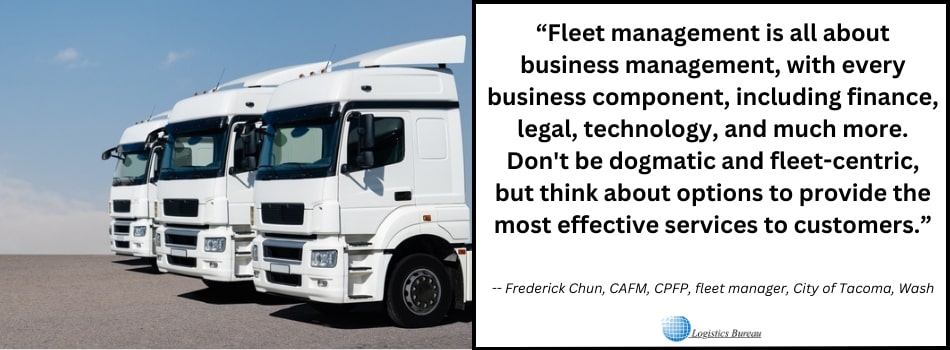
There are ways and means to reduce excess expenditure in fleet operation, and you can separate them roughly into three categories. The first category is truck expenditure, the second is driver expenditure, and the third is workload expenditure.
In this post, we’re sharing our top tips for cost reduction in each of these three areas, so let’s get to it, beginning with truck expenditure.
How to Reduce Truck-Related Costs
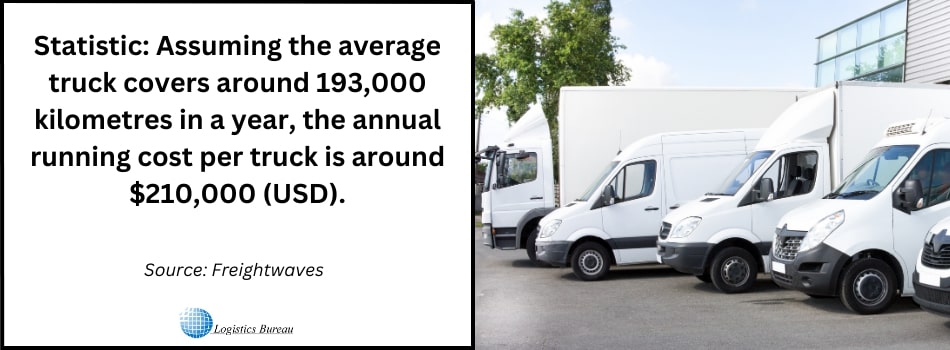
Trucks and vans are not cheap to run, so if you can save even a little on the cost of operating each vehicle in your fleet, those savings can mount up to a lot—and the more extensive your truck fleet, the more you can save. The following tips should prove helpful in getting those truck running costs down.
1. Consider Downsizing Your Fleet
Reducing fleet size might be the most drastic option for cost reduction, but it’s also the one likely to deliver the most significant savings. If it sounds like an unlikely option, consider how your fleet came to be the size it is.
Was your fleet size and makeup designed from scratch, or did it evolve organically like many companies’ in-house transportation operations?
If your fleet has evolved into its present scale and composition, there may be opportunities to decrease the number of vehicles you use. Considerations could include the following:
- How efficiently do you utilise the load capacity of your trucks or vans?
- Do you have any specialised vehicles, and could they be removed by changing how you operate?
- Are any of your trucks underutilised due to limitations or fluctuating workloads in a specific geography?
Fleet Downsizing Considerations
Removing just one vehicle from your fleet could save thousands of dollars annually. While some of those savings will be offset by additional mileage and wear and tear on the remaining trucks, the net gain will still be substantial.
Getting rid of vehicles might be challenging, but it’s worth striving towards as a cost-saving goal. If you can’t see any apparent opportunities, ask yourself if it’s possible to create some, for example, by splitting the workload into shifts, enabling your vehicles to operate around the clock and reducing the time they spend parked up.
Another asset-reduction strategy is to outsource your transportation for particular categories or locations. That can help you reduce the number of trucks under your company’s ownership. But, of course, the overall costs and other outsourcing pros and cons require careful consideration before making such a move.
2. Retread Truck Tyres Instead of Buying New Ones
Tyres are typically the second-highest fleet expense after fuel. Still, retreading truck tyres several times before their end-of-life is a common practice, making it a viable and high-yielding cost-reduction measure. If your distribution fleet comprises large goods vehicles, you can save much money on tyres by retreading them instead of replacing them when the original treads wear down.
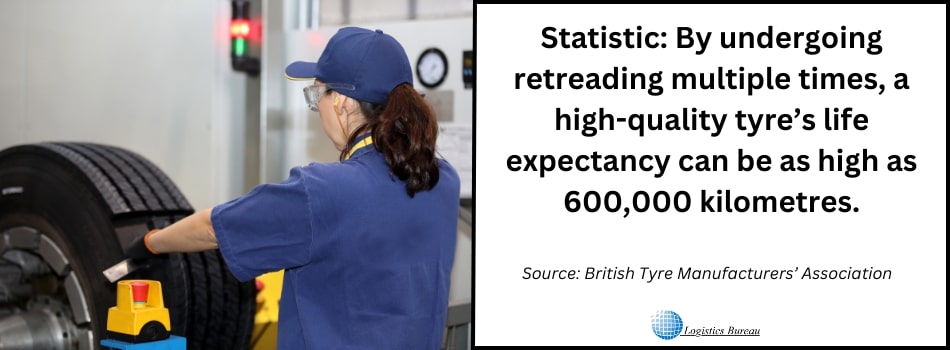
But what if you typically use low-cost tyres in the first place? It’s a fair question. Cheap imported tyres can deliver savings for your distribution fleet, but they may not be suitable for retreading, meaning you will need to purchase new tyres more often.
Meanwhile, a high-quality tyre, costing more to purchase initially, can see its usable life extended by 50% to 90% with each retread. Furthermore, the cost of retreading is a mere 40% to 50% of the initial purchase price of a quality tyre.
Retreaded Tyres: Are They Safe?
While myths do abound about the safety aspect of retreaded tyres, studies conducted on behalf of government departments around the world, such as the Washington State Department of Transportation in the United States, have shown that, in general, retreaded tyres are not dangerous.
Nevertheless, when you use retreads, it’s critical to establish a maintenance policy which includes frequent checks for correct tyre inflation pressure and scrutiny of tyre condition.
3. Maintain Correct Tyre Pressures
To keep the focus on tyres for a moment and, more specifically, their pressures, there is a direct link between tyre pressures and fuel consumption. We’ll talk more about fuel consumption in later sections of this post, but the impact of tyre pressures makes for a natural follow-on to point #2 above.
Maintaining tyres at their manufacturers’ recommended pressures is a sure way to help limit your distribution fleet’s fuel consumption. Low tyre pressure reduces fuel economy by around 0.2% for every one psi of under-inflation.
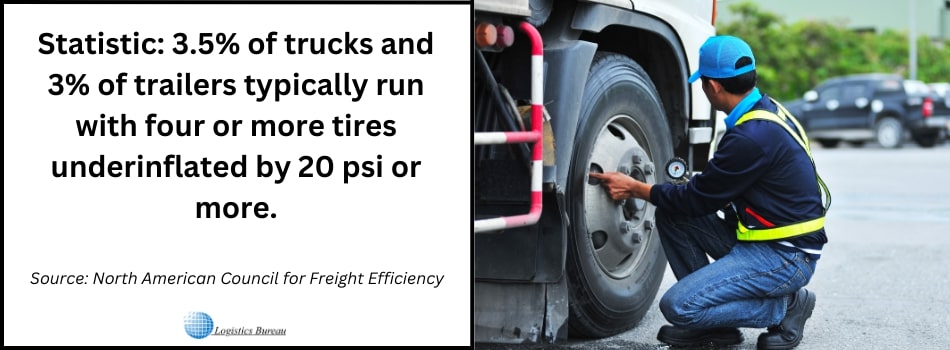
So, for example, if a truck has two of its tyres underinflated by five psi, its fuel economy degrades by around 2% (that’s 1% per under-inflated tyre). Over an entire fleet, that can mount up to much unnecessary fuel expenditure.
With this knowledge, it’s easy to see how regular tyre pressure checks are essential for curbing fuel costs and why you should consider them a mandatory step in daily vehicle inspection regimens.
4. Retire High-Mileage Vehicles
Running your older distribution trucks into the ground to avoid capital expenditure is always tempting, but it’s almost always a false economy. High-mileage trucks spend more time in the workshop, burn more fuel, and cost more in spare parts than their newer counterparts.
Because it’s tricky to determine the point at which a truck’s running costs outweigh its value to your company, it’s a good idea to set a mileage threshold at which each distribution vehicle will be retired and replaced with a new asset.
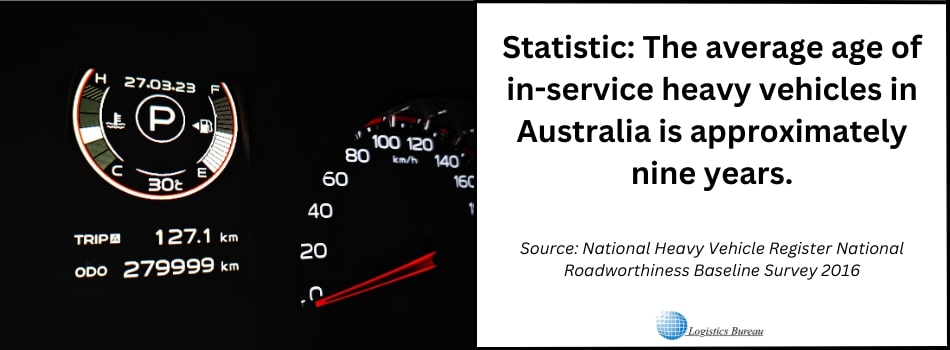
The initial cost of a new truck to replace an old one may be high. Still, it’s a cost that offers a return and helps to prevent inefficiencies in your transportation operation, which would otherwise get in the way of your cost-saving goals.
5. Reduce Truck Acquisition Costs
The cost to purchase new trucks makes up a large chunk of distribution fleet expenditure. So reducing acquisition costs should be a priority for shrewd fleet operators. Here are some potential options to consider in the quest to get more trucks for less outlay:
Rationalise Truck Specifications
Between the natural desire to operate a versatile and capable truck fleet and the upselling tendency of dealers and truck bodybuilders, it’s easy to fall into the trap of over-engineering your new trucks.
It’s often possible to lower acquisition costs by reviewing truck specifications, ruthlessly paring them down to comprise only the necessary functions and features, and paying greater attention to individualised specifications based on the distribution routes and scenarios in which a new truck will be deployed.
Choose Leasing as an Alternative to Buying
If you typically acquire your trucks outright, a switch to leasing can reduce capital expenditure and perhaps help you to unload a portion of your fleet management burden, especially as the leasing market is becoming more competitive and accessible, with manufacturers increasingly offering generous customisable packages for distribution fleet operators.
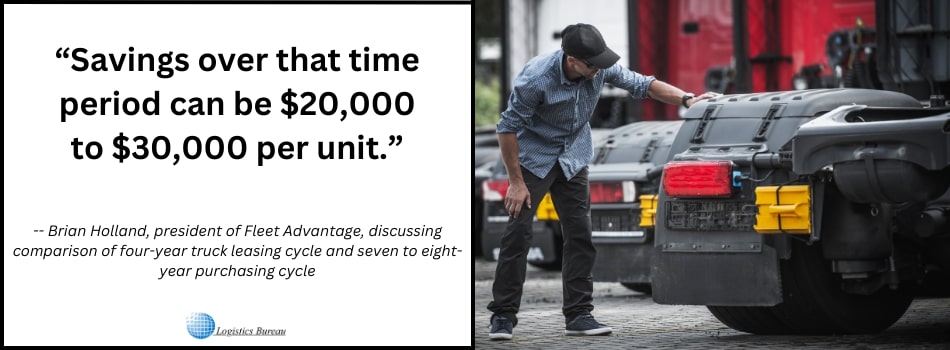
Another benefit of truck fleet leasing is the potential for earlier replacement of vehicles, helping to reduce the costs associated with running older trucks.
Look for Undervalued/End-of-Range Trucks to Acquire
Every truck dealer reaches a point where new model launches create difficulties in selling their predecessors. So it may be possible to reduce acquisition costs by buying those undervalued vehicles, provided they suit your needs.
In summary, cutting the costs related to the vehicles in your distribution fleet requires a focus on maintenance, fleet size and mix, vehicle specifications, and the cost of acquisition.
If you’re considering fleet optimisation as a path to cost reduction, Logistics Bureau can help. Our transportation specialists will be pleased to discuss your needs and challenges and suggest ways that they can assist you in meeting them. It will cost you nothing to engage in that initial consultation—so why not contact us?
If you’d like some help reducing costs in your distribution fleet, book your free consultation here.
How to Reduce Driver-Related Costs
We could continue to talk about truck-related distribution fleet costs. However, at some point, the topic would drift into measures requiring your drivers’ cooperation, so it makes sense to turn now to how you can enlist the help of your drivers to assist you in fleet cost savings.

1. Use Training to Encourage Economic Driving Techniques
The way your employees drive their trucks affects the quantity of fuel needed to run your fleet. Exceeding speed limits, accelerating hard, and braking late are all habits that increase the risk of accidents and consume fuel unnecessarily.
Furthermore, if your fleet comprises large goods vehicles, drivers’ gearbox use also plays a critical role in fuel economy.
A good driver training program that encourages judicious use of each truck’s gears (shifting in the proper increments and at the correct times), and efficient application of the accelerator and brakes, will go a long way to curbing undesirable driving habits.
Although you might feel that as professionals in their field, truck drivers should come ingrained with the correct behaviours for minimising fuel consumption, the reality is often surprising. Freshly qualified drivers may only have the knowledge needed to get them successfully through their driving test, while those who have been in the profession for years often pick up bad habits during their careers.
Driver Training: Is it Worth the Cost?
Efficient driving does not have to cost an arm and a leg in training costs. You could look for a training organisation that offers train-to-train courses. Next, pick a few of your best drivers, enrol them on the course and get them certified as trainers. Then you can deploy them to train the rest of your fleet’s workforce.
The fuel savings gained when a single driver engages in efficient driving will only amount to a few dollars daily. Still, over an entire fleet, especially a large one, it can make a massive difference to annual fleet costs.
2. Curb Idle Habits
Is a complete driver training program an impractical step to take for your company right now, or is it something that you need to plan for the future? If so, there are more immediate ways to engage your drivers in distribution fleet cost savings. For example, you don’t need a training program to educate your workforce about excessive truck idling.
Aside from burning costly fuel unnecessarily, excessive idling increases the wear and tear on your fleet trucks, making it a double whammy in terms of cost excess. Moreover, while it might appear counterintuitive, it requires less fuel to restart a truck engine after shutting it off than is used in just ten seconds of idling time.
While advanced systems are available today to physically control idling time, they can be costly. However, a program of driver briefings, informing about the costs of engine idling and encouraging drivers to shut off their trucks when stationary for more than a couple of minutes can go a long way to reducing annual fuel consumption and truck wear in your distribution fleet.
3. Go Hard on Health and Safety
Much of the advice in this guide has focused on reducing vehicle costs, but please remember that your drivers are a cost in their own right. You must pay their salaries when they are working for you and pay for their replacements when they are not. In all likelihood, they will cost you even more money in the event of workplace-related accidents or health problems.
By taking meaningful steps to eliminate or reduce the hazards to which your operation exposes drivers, you can keep those health and safety issues, and their costs, to a minimum.
How to Improve Health and Safety for Drivers
In your drive (excuse the pun) to improve health and safety for your distribution fleet employees, you might want to consider the following measures:
- Establishing an accident and near-miss reporting regime (for all incident types, including non-driving tasks such as loading and unloading, lifting and carrying, and working/manoeuvring on truck beds).
- Implementing a training program to cover defensive, as well as efficient, driving.
- Tasking your drivers with pre and post-trip vehicle inspections (in many countries these are, in any case, required by law).
- Developing robust schedules for preventative vehicle maintenance, and adhering to them.
- Ensuring that your drivers’ workloads do not invite the temptation to skip or deviate from mandatory break and rest periods, and that drivers are not penalised for taking additional breaks in the event of fatigue, drowsiness, or other situations that impair alertness.
4. Implement a Driver Workforce Shift Pattern
Your distribution fleet assets only pay for themselves when engines run, and wheels turn. Every minute that a truck or driver sits idle is time wasted. We’ve already mentioned how running trucks in shifts can allow you to reduce the number of vehicles in your fleet, but we’ll raise it again here because to operate a shift pattern, you need the help of your drivers.
As an example, let’s say you have a fleet of 22 trucks operating for eight to ten hours daily. Now, let’s consider a scenario where you keep your trucks running for 16 to 24 hours daily, in two or three shifts, with a fresh driver for each shift.
You may need to hire more drivers to operate such a pattern, and it depends on the possibility that some of your customers will accept deliveries throughout the day and night.
However, you will no longer need a fleet of 22 trucks. You may not be able to halve the size of your fleet, but you should be able to reduce its size to 15 vehicles or thereabouts, allowing full coverage even as trucks are stood down for maintenance.
The Benefits of Multi-shift Distribution
Aside from the savings involved with running fewer vehicles, running a multi-shift distribution operation can offer other cost benefits. For instance:
- You might allow your drivers to work shorter shifts, which is good for health and safety.
- You may be able to offer more frequent deliveries or shorten lead time, boosting service performance and perhaps gaining business as a result (depending on the nature of your distribution operation)
- Night shifts may be more productive, due to reduced road traffic and less congestion at delivery points.
Switching from a single shift to a multi-shift operation is a driver and truck-related method of reducing fleet costs. However, it also has an interdependency with your fleet’s workload. That’s a nice segue into discussing other workload-related ways to save money in your distribution fleet operation.
But before we do that, we’d like to mention that we understand the opportunities and challenges associated with employee training, education, and change management here at Logistics Bureau.
If you’d like help planning or implementing driver-related cost-saving measures in your distribution operation, our consultants will be pleased to guide and assist you.
Need help reducing distribution fleet costs? Book a free consultation here.
How to Reduce Workload-Related Costs
Let’s first define what we’re calling workload expenditure in the context of this post. Workload expenditure is those costs that cannot be saved by making changes relating to vehicles in isolation or solely to the workforce but to which measures can be applied across multiple aspects of a distribution fleet’s operation.
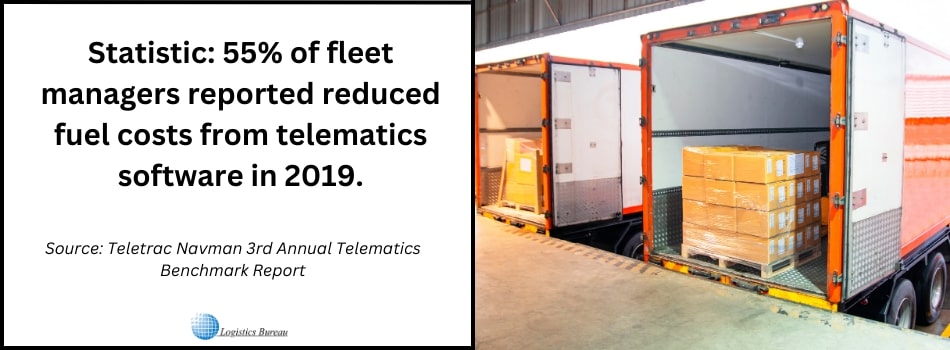
Now that the definition is clear, let’s consider two relevant possibilities.
Reduce Fleet Mileage
Earlier in this post, we touched on the reduction of fuel consumption. Aside from fuel-efficient driving practices, the other fundamental approach to using less fuel is to bring down the mileage that your distribution fleet travels.
So how do you reduce mileage? You certainly don’t want to limit the number of customers, although it’s a good idea to try and reduce the frequency of their deliveries. One way to do this is to incentivise customers to place larger orders at less frequent intervals. That may have the added benefit of increased vehicle capacity utilisation, so it’s always an option worth pursuing.
You can take a couple of approaches to increasing customer order size. One way is to apply a delivery charge to orders under a specific size, or to offer free deliveries, say, once per week on an assigned day, with fees applicable to any extra orders requiring delivery before the next free one.
Another option is to offer price discounts for larger orders that take into account calculated savings on distribution costs.
1. Optimise Routes for Reduced Mileage
Optimising your fleet vehicles’ routes is another way to reduce fleet mileage. It’s also one of the easiest ways if you have access to the sophisticated route planning and optimisation software that has become widely available.
These solutions run complex algorithms taking into account truck capacities, customer delivery time windows, road speeds, road types and traffic volumes, and other factors to create optimum routes and, in some cases, loading plans for hundreds of delivery orders in the time taken to plan one or two routes using manual methods.
Therefore, not only can route planning applications reduce the miles your trucks cover daily, but they can also cut labour costs in your transport office. The best systems include integration with vehicle telematics and in-cab navigation software, enabling seamless planning and management of routes, trucks, and drivers.
In short, route planning and optimisation software applications are essential for operators serious about reducing distribution fleet costs. When well implemented, it should quickly deliver sufficient savings to pay for itself several times over.
2. Use Telematics and Fleet Management Software
In addition to optimising truckloads and vehicle routes, the latest digital solutions can be a boon to distribution fleet management in other ways too. For example, with the integration of onboard telematics in your vehicles and a fleet management system, many of the cost-saving measures mentioned in this post will be much easier to apply and monitor.
Here are three of the ways that telematics and fleet management software can help you cut fleet costs.
1) These solutions allow you to track vehicle progress, status and location in real time, ensuring your drivers follow the optimised routes assigned by your planners and adhere to your country’s laws relating to breaks and rest periods.
2) They also let you see how efficiently each vehicle is being driven and can alert you to unsafe and uneconomical driving practices such as speeding or excessive idling.
3) Adding in-cab cameras that track drivers’ eye and head movements means you can monitor drivers for less obvious risks including drowsiness or distracted behaviour (such as using mobile phones while driving).
4) And, of course, GPS tracking and telematics hardware can also alert you when a vehicle breaks down or is at risk of doing so, saving a great deal of time in guiding technicians to the breakdown site or the truck driver to the most convenient workshop location for remedial maintenance.
These capabilities combine to offer possibilities to reduce fuel, maintenance, labour, and other costs associated with operating a distribution truck fleet—prospects that transport managers of yesteryear could only dream of. That’s why integrating telematics, GPS tracking, and AI-based monitoring software should be a serious consideration for your enterprise—even more so if your fleet comprises more than a handful of trucks.
Ready to Save Money on Distribution Fleet Costs?
While this is a reasonably comprehensive guide to distribution fleet cost reduction, it is not an exhaustive list of possibilities. Nevertheless, the ideas presented here should provide some food for thought.
If you believe your distribution fleet costs more to run than it should, it can help to have an external expert, like one of our consultants, take an objective and dispassionate look at your operation.
Our team frequently conducts client projects to reduce fleet costs, and their trained eyes can often spot opportunities easily missed by managers in the thick of the day-to-day business.
We’ll gladly discuss your fleet costs and help you identify and implement measures to reduce them. An initial consultation with us will cost nothing for your business, and in our discussion, we’ll even offer some ideas that you can test right away… Then, of course, if you decide you’d like us to become more directly involved, we can take further discussions to determine how best to assist you.
Ready to discuss your fleet costs and possible savings opportunities? Book your free consultation now.
- SEO Powered Content & PR Distribution. Get Amplified Today.
- PlatoAiStream. Web3 Data Intelligence. Knowledge Amplified. Access Here.
- Minting the Future w Adryenn Ashley. Access Here.
- Buy and Sell Shares in PRE-IPO Companies with PREIPO®. Access Here.
- Source: https://www.logisticsbureau.com/how-to-operate-your-distribution-truck-fleet-at-less-cost/



